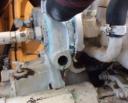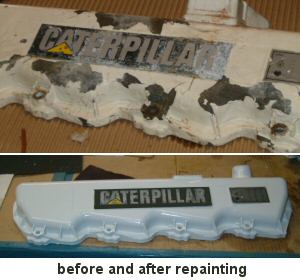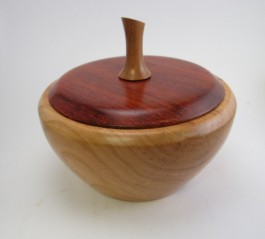
My wife has off today for
Columbus Day. It occurred to me that very few people get a holiday in their honor for making a mistake (from
History.com :
The explorer Christopher Columbus made four trips across the Atlantic Ocean from Spain: in 1492, 1493, 1498 and 1502. He was determined to find a direct water route west from Europe to Asia, but he never did. Instead, he accidentally stumbled upon the Americas) I guess I just haven’t made the
right mistake yet. I wonder if government employees will get a paid holiday since the government s
eems to be out of business?
Most people are in Oxford today doing (
your guess here). It was nice having an extra day off on Friday and I understand we may have more, at least until we start hauling boats for storage — then the craziness should kick in. I have one guy over here doing travel lift maintenance in anticipation of that craziness — we don’t need any problems during that time.
Once again I am hitting the tips section for content —
just in case you are looking for winter projects:
February 28th, 2008
We see a lot of engines which are in need of a make-over (I mean a lot). How do you know when you need a make-over? When a potential buyer sees an engine with rust or corrosion, it is a sign that the boat has not been maintained properly. Since engine work can cost a lot of money, it is a definite deterrent to a potential buyer.

The first step in reviving an engine like this is not to jump into the job, but determine what caused the rust and corrosion. It is no good to fix the symptoms without knowing the cause. All engine cosmetic problems are caused by leaks – period. It may be the engine, an engine pump, a hose or even another piece of equipment that is spraying water on the engine. You need to have the engine running and other equipment that is located nearby to determine the actual problem.
At this point, all hoses and clamps should also be inspected. Hoses do dry rot and if they get oil on them, it will shorten the life so replace if necessary even if you suspect they are getting close to the end of their lifespan. Any parts that can be easily removed should be. It is much easier to get a good cleaning and paint job if the parts are on the bench.

The paint you use should be the OEM or equivalent to maintain the value of the engine. If you are not using OEM paint, be sure the paint can handle the high temperatures that the engine produces. The surfaces should be as clean as possible and degreased properly so the new paint will adhere properly and for the long haul. On the photo to the right, the paint looks a little different because the white CAT paint will yellow over time.
When reassembling the parts, you should ALWAYS use new gaskets. For the small amount of money you would save by reusing a gasket, you will probably ending doing the job again due to the leaking gaskets. As far as I know, no gaskets are reusable on an engine.
Many problems are caused by
leaking water pumps. This is a separate problem unto itself. What happens when a pump corrodes is that rust flakes will get into the pump. Any that make their way onto the shaft will score it. A score in the shaft will ruin the pump as the seal will no longer keep the water from leaking out. You can rebuild a pump, but if the shaft is scored it is cheaper to replace it. Most of the cost of a pump is in the shaft. After buying the seals, the shaft and an impeller in addition to the mechanic’s labor, you have spent as much as you would for a new pump. It’s like repairing a television set – nowadays it is cheaper to replace it than fix it.
When painting the parts that are still on the block, it is important to mask all openings left from removing parts, masking all hoses and wire and protecting the other equipment from over spray. This will give you a professional looking job.
The job is not complete until you totally clean and dry your drip pans. This is important because you will be laying oil sorb cloths under the engines. After getting the cloths laid in, you will want to run your engine for a while and look for leaks. If you see any signs on the oil sorb cloths, immediately find out where they are coming from and fix.
It is a lot of work to revive an engine, but worth it for maintaining the health of your boat.

I got in 3 solid days in the workshop but I won’t bore you with all the projects I dabbled with. This piece I particularly liked and I actually had about 5 hours getting it from log to shelf-ready. I call it the Cherry Apple. You can see more photos of this piece in my
turning blog.
 My wife has off today for Columbus Day. It occurred to me that very few people get a holiday in their honor for making a mistake (from History.com : The explorer Christopher Columbus made four trips across the Atlantic Ocean from Spain: in 1492, 1493, 1498 and 1502. He was determined to find a direct water route west from Europe to Asia, but he never did. Instead, he accidentally stumbled upon the Americas) I guess I just haven’t made the right mistake yet. I wonder if government employees will get a paid holiday since the government seems to be out of business?
Most people are in Oxford today doing (your guess here). It was nice having an extra day off on Friday and I understand we may have more, at least until we start hauling boats for storage — then the craziness should kick in. I have one guy over here doing travel lift maintenance in anticipation of that craziness — we don’t need any problems during that time.
Once again I am hitting the tips section for content — just in case you are looking for winter projects:
My wife has off today for Columbus Day. It occurred to me that very few people get a holiday in their honor for making a mistake (from History.com : The explorer Christopher Columbus made four trips across the Atlantic Ocean from Spain: in 1492, 1493, 1498 and 1502. He was determined to find a direct water route west from Europe to Asia, but he never did. Instead, he accidentally stumbled upon the Americas) I guess I just haven’t made the right mistake yet. I wonder if government employees will get a paid holiday since the government seems to be out of business?
Most people are in Oxford today doing (your guess here). It was nice having an extra day off on Friday and I understand we may have more, at least until we start hauling boats for storage — then the craziness should kick in. I have one guy over here doing travel lift maintenance in anticipation of that craziness — we don’t need any problems during that time.
Once again I am hitting the tips section for content — just in case you are looking for winter projects:
 The first step in reviving an engine like this is not to jump into the job, but determine what caused the rust and corrosion. It is no good to fix the symptoms without knowing the cause. All engine cosmetic problems are caused by leaks – period. It may be the engine, an engine pump, a hose or even another piece of equipment that is spraying water on the engine. You need to have the engine running and other equipment that is located nearby to determine the actual problem.
At this point, all hoses and clamps should also be inspected. Hoses do dry rot and if they get oil on them, it will shorten the life so replace if necessary even if you suspect they are getting close to the end of their lifespan. Any parts that can be easily removed should be. It is much easier to get a good cleaning and paint job if the parts are on the bench.
The first step in reviving an engine like this is not to jump into the job, but determine what caused the rust and corrosion. It is no good to fix the symptoms without knowing the cause. All engine cosmetic problems are caused by leaks – period. It may be the engine, an engine pump, a hose or even another piece of equipment that is spraying water on the engine. You need to have the engine running and other equipment that is located nearby to determine the actual problem.
At this point, all hoses and clamps should also be inspected. Hoses do dry rot and if they get oil on them, it will shorten the life so replace if necessary even if you suspect they are getting close to the end of their lifespan. Any parts that can be easily removed should be. It is much easier to get a good cleaning and paint job if the parts are on the bench.
 The paint you use should be the OEM or equivalent to maintain the value of the engine. If you are not using OEM paint, be sure the paint can handle the high temperatures that the engine produces. The surfaces should be as clean as possible and degreased properly so the new paint will adhere properly and for the long haul. On the photo to the right, the paint looks a little different because the white CAT paint will yellow over time.
When reassembling the parts, you should ALWAYS use new gaskets. For the small amount of money you would save by reusing a gasket, you will probably ending doing the job again due to the leaking gaskets. As far as I know, no gaskets are reusable on an engine.
Many problems are caused by leaking water pumps. This is a separate problem unto itself. What happens when a pump corrodes is that rust flakes will get into the pump. Any that make their way onto the shaft will score it. A score in the shaft will ruin the pump as the seal will no longer keep the water from leaking out. You can rebuild a pump, but if the shaft is scored it is cheaper to replace it. Most of the cost of a pump is in the shaft. After buying the seals, the shaft and an impeller in addition to the mechanic’s labor, you have spent as much as you would for a new pump. It’s like repairing a television set – nowadays it is cheaper to replace it than fix it.
When painting the parts that are still on the block, it is important to mask all openings left from removing parts, masking all hoses and wire and protecting the other equipment from over spray. This will give you a professional looking job.
The job is not complete until you totally clean and dry your drip pans. This is important because you will be laying oil sorb cloths under the engines. After getting the cloths laid in, you will want to run your engine for a while and look for leaks. If you see any signs on the oil sorb cloths, immediately find out where they are coming from and fix.
It is a lot of work to revive an engine, but worth it for maintaining the health of your boat.
The paint you use should be the OEM or equivalent to maintain the value of the engine. If you are not using OEM paint, be sure the paint can handle the high temperatures that the engine produces. The surfaces should be as clean as possible and degreased properly so the new paint will adhere properly and for the long haul. On the photo to the right, the paint looks a little different because the white CAT paint will yellow over time.
When reassembling the parts, you should ALWAYS use new gaskets. For the small amount of money you would save by reusing a gasket, you will probably ending doing the job again due to the leaking gaskets. As far as I know, no gaskets are reusable on an engine.
Many problems are caused by leaking water pumps. This is a separate problem unto itself. What happens when a pump corrodes is that rust flakes will get into the pump. Any that make their way onto the shaft will score it. A score in the shaft will ruin the pump as the seal will no longer keep the water from leaking out. You can rebuild a pump, but if the shaft is scored it is cheaper to replace it. Most of the cost of a pump is in the shaft. After buying the seals, the shaft and an impeller in addition to the mechanic’s labor, you have spent as much as you would for a new pump. It’s like repairing a television set – nowadays it is cheaper to replace it than fix it.
When painting the parts that are still on the block, it is important to mask all openings left from removing parts, masking all hoses and wire and protecting the other equipment from over spray. This will give you a professional looking job.
The job is not complete until you totally clean and dry your drip pans. This is important because you will be laying oil sorb cloths under the engines. After getting the cloths laid in, you will want to run your engine for a while and look for leaks. If you see any signs on the oil sorb cloths, immediately find out where they are coming from and fix.
It is a lot of work to revive an engine, but worth it for maintaining the health of your boat.
 I got in 3 solid days in the workshop but I won’t bore you with all the projects I dabbled with. This piece I particularly liked and I actually had about 5 hours getting it from log to shelf-ready. I call it the Cherry Apple. You can see more photos of this piece in my turning blog.
I got in 3 solid days in the workshop but I won’t bore you with all the projects I dabbled with. This piece I particularly liked and I actually had about 5 hours getting it from log to shelf-ready. I call it the Cherry Apple. You can see more photos of this piece in my turning blog. 
